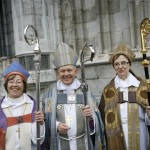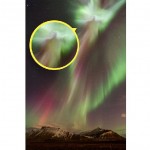 On the week before Christmas in 1941 my grandfather was walking with his two sons to market in downtown Pottstown, Pennsylvania. It had snowed the night before and the roads were too icy to drive. That’s why they were walking. As they crossed the river bridge a coal truck turned on to the bridge. The bridge was icy and the driver lost control. The truck slid forward toward my grandfather and his sons. He saw what was happening, pushed the boys out of the way, but was himself crushed by the careening coal truck. Passers by folded his body into the back seat of a car and rushed him to hospital, but as they did his broken ribs punctured his internal organs and the doctors could do nothing for him. As he lay dying on Christmas Day my grandmother kept vigil by his bedside. Then he awoke for a moment from his unconscious state. He recognized his wife, squeezed her hand and they prayed together. Then he smiled and looked up into the corner of the hospital room. His face brightened and she said he looked young again. He said quietly, “Look! look! Don’t you see them? They’re so beautiful!” Then his head fell back on the pillow and he was gone.
On the week before Christmas in 1941 my grandfather was walking with his two sons to market in downtown Pottstown, Pennsylvania. It had snowed the night before and the roads were too icy to drive. That’s why they were walking. As they crossed the river bridge a coal truck turned on to the bridge. The bridge was icy and the driver lost control. The truck slid forward toward my grandfather and his sons. He saw what was happening, pushed the boys out of the way, but was himself crushed by the careening coal truck. Passers by folded his body into the back seat of a car and rushed him to hospital, but as they did his broken ribs punctured his internal organs and the doctors could do nothing for him. As he lay dying on Christmas Day my grandmother kept vigil by his bedside. Then he awoke for a moment from his unconscious state. He recognized his wife, squeezed her hand and they prayed together. Then he smiled and looked up into the corner of the hospital room. His face brightened and she said he looked young again. He said quietly, “Look! look! Don’t you see them? They’re so beautiful!” Then his head fell back on the pillow and he was gone.
This is a true story, but on what level is it true? On one level it is a factual account of a historical event which took place seventy years ago. My mother still has the news clippings. My two uncles are still living and can tell the tale. In my re-telling I may have missed some details or got the words a bit wrong, but when I do my mother is quick to correct me.
If we compare this true story to the stories of the gospels we can assess in what way the gospels might also be true. The comparison is illuminating because of the passage of time. My story of my grandfather’s death seventy some years ago is being remembered and told today. The gospel stories were re-told and then recorded only thirty to forty years after the events.
In treating the stories, there are facts to be recorded, and then there is interpretation of the facts. My mother and my uncles readily correct the details if I get them wrong because the details are important. For those for whom the stories are precious, the facts are precious because the people involved are precious. These are fragile and beloved events. Those who experienced them do not want them embroidered or exaggerated.
However, there is also the interpretation of the events. There is a redemptive theme to the true story. My grandfather laid down his life for his sons. My grandmother soldiered through the depression and war years as a young widow. Her courage and hard work and abiding love for her husband became an example of goodness, loyalty and faith in our family. These teaching elements are woven through the story and spring from the story and its aftermath. There is more. There is also a supernatural element to the story. For those who believe, my grandfather had a glimpse of heaven before he went there. He saw the angels who were ready to welcome him home.
This story “works on us as myth” because my grandfather (who I never knew) has become an iconic figure in our family history. The heroic story of his noble self sacrifice inspires us and encourages us to follow his example. We identify with him as the hero. As husbands and fathers we want to be as noble, courageous, good and true as we believe he was. This is the way myths work–the hero gets into us and we get into him. His story lives on in us.
For those who do not believe it might be suggested that this last part of the story was a “mythological element” that had intruded into the telling of the story by later generations who had come to venerate my grandfather as a saintly and self sacrificial hero. The true and tragic story, they would say, had become legend and legend had become myth. Others who are more doubtful might suggest (after the passing of a few more generations) that the story (because it had mythological elements) was completely myth. It was something made up by the family members to elevate my grandfather’s status.
They suggest that this was the way the gospels evolved. Jesus of Nazareth did certain things that seemed miraculous. Before long those elements were exaggerated and the Gentile church made him into a divine figure like the other man-gods in their culture. It’s a plausible theory if you don’t know very much about the Jews and New Testament culture.
The problem is the Jews were a very hard headed and practical people. They had no time for the myths and legends of the pagans. In fact, the pagan religions were the chief enemy and it was blasphemy to imagine that a man could be God. This is why the witness of St Paul–whose remarkable writings are the earliest New Testament documents–is so astounding. Here is a well educated and thoroughly trained Jewish theologian who goes completely against his religion and says that “Christ Jesus was in the form of God” or “Christ is the image of the unseen God” or “Jesus Christ is Lord of Heaven and Earth.”
These claims are made before his death in the mid-60s. Just thirty years after the death of Christ. The “mythological elements” therefore were in place well within the memory of those who were witnesses to the events of Christ’s life. Furthermore, when the gospels are studied in depth it becomes clear that dozens of examples woven into the heart of the stories themselves reveal Jesus Christ as God. These are all the more believable because they are woven into the ordinary actions and words of Christ rather than something attached to the story later as an accretion.
One example is the story of the healing of the paralytic man: Jesus doesn’t just heal the man. He forgives his sins. The Pharisees say quite rightly, “Who does he think he is? Doesn’t he know that God alone can forgive sins?” Christ’s words and actions reveal his divinity rather than it being a later addition to a memorable story. This is like the supernatural element in the story of my grandfather’s death. It is part of the story and it really happened that way. The supernatural took place within the natural world.
This is why any comparison of the Jesus stories to pagan myth simply doesn’t stand up. Those who say that the stories of Jesus are like the stories of Attis or Horus or Dionysius have clearly not read either the gospels or the ancient myths. Here’s an example: some would like to suggest that the birth of Horus (because it was a miraculous birth) was a “Virgin Birth” and therefore the Christians borrowed the story from the pagans. Stop and look at the Horus story: His mother Isis the river goddess gathered the dismembered parts of the body of her husband Osiris, but she couldn’t find his penis so she fashioned a golden penis and impregnated herself and conceived Horus–and this is typical of the outlandish nature of totally mythological stories.
The story of the conception of Jesus Christ is admittedly a supernatural story–an angel appears to a girl and she becomes pregnant by an act of God, but this is nothing like the pagan myths. It is much more like the story of my grandfather’s death–an ordinary situation is transformed by a supernatural occurrence. This world is interrupted by the other world, and so transformed.
That such true stories can become legend and then work on us as myth is illustrated by the story of my grandfather’s death–and examples could be multiplied endlessly–and each one shows how the gospel stories work as well: that they work on us like myths, except that they really happened.
Finally, we mustn’t pretend that the gospel is limited to this natural “mythic way of working”. The Catholic religion is more than following a collection of inspiring stories. Because Jesus Christ was God incarnate his power and working in the world is constant and active. Added to the “inspiring stories” is the abiding presence of the Holy Spirit and the graces which come through faith and the sacraments of the church….but that is another story.















